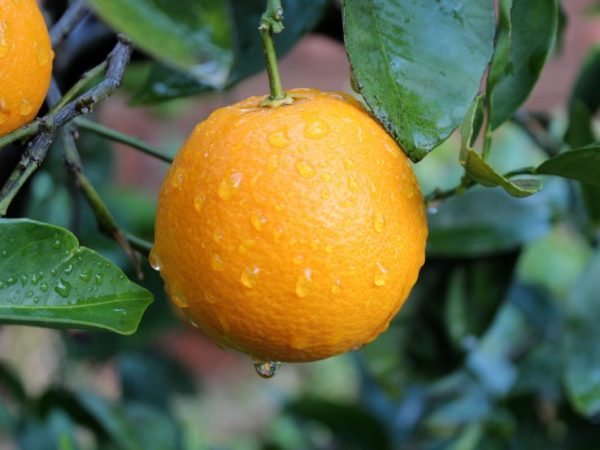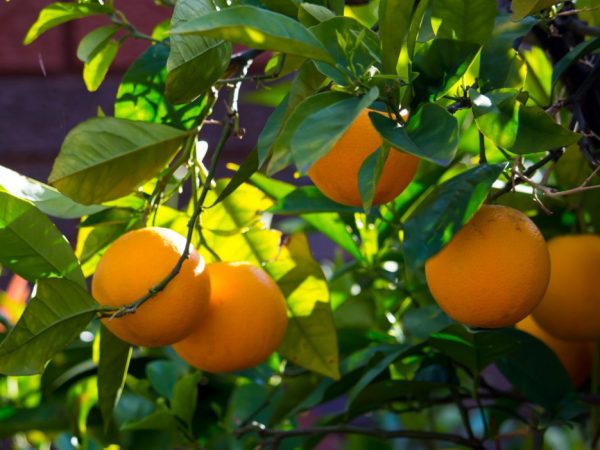Description of the Washington Navel orange
Growing exotic plants at home is an interesting practice. It can be flowers, trees or shrubs, pleasing in appearance, and sometimes fruit. One of the most famous and curious plants is the Washington orange.

Description of the Washington Navel orange
Characteristics of an orange
The word "Navel" is translated as "navel". The orange was named so because of the navel-like appendage on the nose of the fruit. This is what an underdeveloped second fetus looks like.
Plant features
According to the description, the Washington Navel orange belongs to the early maturing. It has the following features:
- At home, an orange tree grows up to 1-2 m.On the open field it can reach 4 m. The branches are thin, long, which is why they hang down. The leaves are elongated, medium-sized, ovoid, with smooth edges, pointed at the end, have a dark green color and small lion-like processes. In the axils of each leaf there are numerous small spines. The life of the foliage is 2-3 years.
- Flowering Washington Navel occurs in the first half of spring after 3-4 years of plant life. Flowers are placed singly, sometimes in inflorescences. Their size does not exceed 6 cm in diameter. Orange inflorescences have a sweetish smell, pink-white color. Under unfavorable flowering conditions (more often at low indoor temperatures), the buds remain closed for a calendar month. The benefit of thinning the inflorescences is to produce larger fruit with better flavor.
- The fruits of the plant are characterized by a round shape, in rare cases, slightly elongated. Their weight is from 150 g to 300 g. The skin is dense, thick, with a fine-grained structure, does not come off the pulp well, has an orange color, with high humidity in a warm room it becomes paler than usual. The core of oranges is red. The pulp is sweet, high in juice, sometimes with a strawberry aftertaste. There are no seeds in the fruits of Washington Navel, and the fruits easily tolerate transportation and can lie for a long time, retaining their original qualities.
Plant care
According to the description, in order for Washington Naval to give a rich harvest, it is placed near the south or east windows in the house. This gives the variety the maximum amount of daytime sunshine. In the summer, to prevent foliage burns, the dwarf tree is moved into the shade, taken out onto a balcony or terrace - into the open air. In order for the crown to develop evenly and all the fruits have time to ripen, the tub of orange is rotated around its axis every day.
The indoor air temperature depends on the growth period of the plant. For flowering, it is suitable to maintain heat within the range of 15 ° C-18 ° C, for fruiting, the optimum temperature is 25 ° C-28 ° C. Cooling below 5 ° C should not be allowed.
Air humidity also plays an important role. The best option is to spray the foliage once a day. This is especially true in a house with dry air. The same goes for watering.During active vegetation - in spring and summer - the soil at the root is moistened once a day, in the autumn-winter period, the frequency is reduced to 2 waterings per week.
As a top dressing, ready-made mixtures for fertilizing citrus fruits are suitable. Chicken manure is also used, diluted in water in a ratio of 1 to 20 and infused for 7 days. The greatest content of additives is introduced at the beginning of flowering and during the period of active development of the ovary.
Transplanting and pruning a tree

Pruning and replanting trees are done in the spring.
The tree is transplanted and its crown is formed in the spring, before the onset of the active flowering period.
- The variety is transplanted by transshipment, releasing the root system along with a clod of earth and moving it in this form into a new container. The rest of the soil is poured to the top. Pebbles must be poured at the bottom to ensure good drainage.
- The composition of the soil in a pot or tub is important. The mixture consists of sod soil, leafy soil, humus and sand. For seedlings, a ratio of 2: 1: 1: 1 is used, for adult fruit-bearing trees - 3: 1: 1: 1. The optimal transplant frequency is every 2-3 years.
- Branches growing inside the crown, as well as weak and strongly elongated ones, are cut off. Thin the crown so that 1-2 branches of the second order remain on the branches of the first order, 3-5 shoots of the third order remain on the branches of the second order, the branches of the fourth order are the basis for fruiting an orange.
Plant pests
The main pests of the Washington Navela variety are spider mites and scale insects. Methods of dealing with them:
- Only prevention helps against spider mites. To do this, use soap foam, which is applied to the leaves and branches once a month. After waiting for the tree to dry, cover the soil in the pot with polyethylene, after which the soapy foam is washed off with water.
- To destroy scale insects, as well as for prevention purposes, a special emulsion is prepared: 2 tbsp. l. washing powder and 40 g of laundry soap are diluted in a glass of warm water. A cotton swab is moistened with the emulsion, leaves and branches are wiped with it, and after 3-4 hours they are washed off so that the solution does not get into the soil. The procedure is carried out once a week for a month.
Conclusion
Due to the exceptional qualities of the bonsai and the taste of the fruit, the Washington Navel orange is renowned in the world market. It is important to care for this plant properly in order to get a decent harvest of exotic fruits, even in cold climates.


